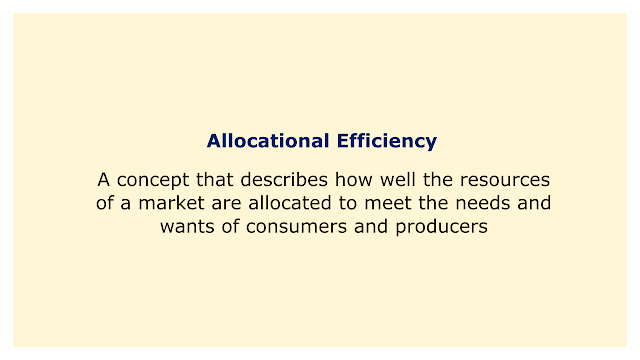 |
| Image: Moneybestpal.com |
Allocational efficiency is a concept that describes how well the resources of a market are allocated to meet the needs and wants of consumers and producers. It is predicated on the notion that an effective market is one in which capital is allocated in a way that is most advantageous to the parties involved.
Allocational efficiency is the best way to distribute goods and services to consumers in an economy, as well as the best way to allocate investor capital to businesses or projects. All goods, services, and capital are dispersed according to their highest and best use in an allocational efficient system.
Looking at the marginal utility and marginal cost of a good or service is one technique to gauge allocational efficiency. The additional pleasure or benefit a consumer receives from consuming one more unit of an item or service is known as marginal utility. The increased cost or expense a producer has as a result of producing one more unit of a good or service is known as the marginal cost. In an effective market, consumers should be prepared to pay exactly what it takes to provide an item or service, or that good's marginal utility should be equal to its marginal cost. This prevents resource waste and improper allocation, as well as over- or underproduction of any good or service.
The consumer surplus and producer surplus in a market are two further indicators of allocational efficiency. Consumer surplus is the discrepancy between the price consumers are prepared to pay and the price they ultimately end up paying. What producers call "producer surplus" is the discrepancy between the price they are ready to accept for a good or service and the price they actually receive. There is no deadweight loss or market inefficiency in an efficient market since both the consumer surplus and the producer surplus are maximized. When a market is not functioning at its best, there is a loss of economic well-being known as "deadweight loss."
However, in reality, allocational efficiency is rarely achieved in most markets due to various factors that prevent them from being efficient. Some of these factors include:
- Information asymmetry: This happens when one participant in a market has more or better information than another party, providing them a benefit or a disadvantage when making decisions. For instance, a vendor may have a better understanding of a product's quality than a customer, which could cause issues with moral hazard or adverse selection.
- Transaction costs: These are the expenses or costs involved when engaging in a market transaction. They could, for instance, be fees, commissions, taxes, travel expenses, look-up expenses, bargaining expenses, etc. Transaction costs have the potential to lower trading profits and lead to market inefficiencies.
- Externalities: These are the impacts, either positive or negative, that market action has on parties not directly associated with the activity. For instance, pollution is a bad externality that harms the environment and people's health, but education is a good externality that helps society and the economy. Externalities can lead to market failures and distorted resource allocation.
- Market power: This happens when one party in a market has the power to affect the cost or supply of an item or service, either by having a monopoly on the market or by having a monopoly on the market (monopoly). Market power can result in price discrimination, price fixing, collusion, predatory pricing, and other practices that lower competition and decrease market efficiency.
Allocational efficiency is a desirable objective, but markets frequently fall short of it because of various flaws and frictions. Nonetheless, there are ways to increase allocational effectiveness by putting in place laws and guidelines intended to address market imperfections and encourage free and open competition. Some examples of such policies include:
- Antitrust laws: Monopolies and other forms of market power that can hurt consumers and decrease efficiency are prohibited or limited by these laws. By dismantling monopolistic enterprises, blocking mergers and acquisitions that would lessen competition, outlawing anti-competitive behavior, etc., antitrust laws seek to encourage competition and innovation in the market.
- Pigouvian taxes: These taxes are levied on products or services that produce undesirable externalities, such as pollution, traffic, noise, etc. Pigouvian taxes make goods and services more expensive for producers and consumers, lowering their levels of consumption and production in an effort to internalize the societal cost of these externalities.
- Subsidies: The producers or users of goods or services that offer positive externalities, such as education, healthcare, research, and development, etc., receive these payments or incentives. By lowering the cost or increasing accessibility for producers and customers, subsidies are intended to promote the production and use of these goods or services.
- Public goods: These are non-excludable and non-rivalrous commodities or services, which means that no one can be banned from utilizing them and that one person's use does not reduce their availability for others. Examples include the military, public parks, streetlights, and so forth. Due to the free-rider problem, in which people can use public goods without paying for them, the private market frequently provides them insufficiently or not at all. Hence, public goods are typically offered by the government or other public entities that have the ability to charge users of the services taxes or other fees.
